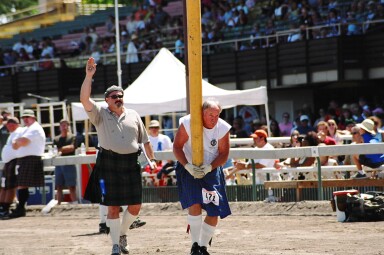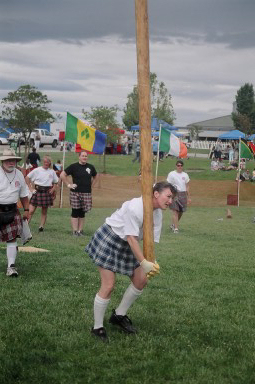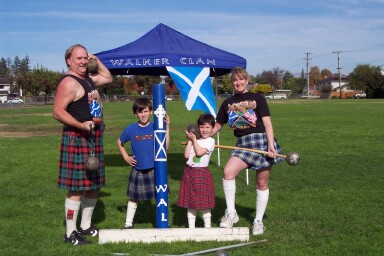|
From the quiet glens and groves of ancient
Scotland comes one of the most physically demanding and technically
challenging sports in existence today. Scottish Highland Heavy Athletics.
It’s origins shrouded in mystery and obscured through the mists of time,
the Highland Games Heavy athletic events remain one of the most popular of
all athletic competitions in the world. Highland Games and Gatherings are
held every year in hundreds of cities across the United States and in
dozens of foreign countries. Over 900 athletes are ranked on the NASGA
(North American Scottish Games Athletics) website.
www.nasgaweb.com/main.asp
The games make a
perfect venue for family fun, whether you all compete or just come to
watch Mom or Dad throw really heavy things! For some it is the smells and
taste of good Scottish cooking. Others are drawn to the games for the
wonderful bands, the exemplary Highland Dancers, the costumed reinactors,
a chance to wear the Kilt, the dog trials, or to search the Clan tents for
their family’s origins and celebrate their culture. There is something
for every member of the family to enjoy through simply watching or in
exciting participation in the celebrations of our ancestors. For the
Walker family, it is all that and a chance to challenge themselves in this
most difficult sport.
What started out as
a casual trip to learn about their ancestors has led the entire Walker
family to become staunch competitors on the modern field of battle. In an
atmosphere of friendship and support they travel all over California in
pursuit of Scottish athletic competition and the camaraderie of the field.
Husband Jim was even blessed last year to compete in the Masters World
Championships in Bught Park; Inverness Scotland The Walker family consists
of husband Jim, wife Heather, and sons Brian and Blake (Nicholson).
Six-month-old Audrey Rose enjoys the Games from the sidelines.
Why would a family
spend several weekends each year traveling all over the state to compete
in one of the toughest athletic competitions in the world you ask?
Certainly the personal challenges of the games is an irresistible draw.
Throwing Highland weights requires incredible strength, balance, and
skill. Each competition represents a new chance to test their inner and
physical strengths to the maximum. But, it is the people they compete
against and the wonderful people at the Games that keeps drawing them
back.
Heather Walker
states, “None of the other sports I have ever competed in comes close to
matching the experience I get at the Highland Games. We dress in our
ancestors’ kilts, compete against some of the best athletes in the world,
and get to listen to the pipes play all day long!”
Jim and Heather
have been competitive all their lives playing all manner of highly
competitive sports. But they always felt pretty much alone in the fiercely
competitive atmosphere. Heather comments: “when I have competed before it
was always every man for themselves.”
Husband Jim adds, “
Heather and I have participated in competitive athletics in one form or
another all our lives. Whether its softball, football, golf, basketball,
tennis, you name it, we have enjoyed it. After 48 years of competing I can
tell you with assurance that there is no more enjoyable or supportive
athletic atmosphere than on the Highland Games Heavy Athletics field of
competition. From the first time I threw the Braemar stone I knew this was
a great place for a family to be. “
“I walked onto the
field at my first competition as a complete novice. This was not a
baseball field or a sport I had played since childhood. I did not even
know most of the rules or regulations. The men surrounding me all looked
like a master Greek marble carver sculpted their muscles. I half expected
to see Hercules there in a kilt. And actually, some of the competitors are
what we would expect the wild Scottish warriors of old to look like.
Massive and strong.
After seeing the
Pro athletes throw a 25-pound stone across the field like a football, I
knew I was WAY out of my league. But this was not your typical competitive
situation. I was not standing on the sidelines for more than 5 minutes
when throwing legend ‘Wild” Billy Butler came and introduced himself to
me. He welcomed me and offered to help me in any way he could. I thought
to myself “ just whom are you trying to kid!”
My skepticism
turned to joy as surprisingly help was offered by Billy and several other
competitors at every single event. One particular incident sticks in my
mind as an example of just how honorable and supportive these athletes are
with everyone that comes out. I must have been quite the sight when my
attempts to throw the Braemar stone landed me on my back on the ground two
times in a row. Billy approached me chuckling with a grin from ear to ear.
Now, if this were any other competition, that smile would have meant the
athlete was on his way to ‘psych me out’ since his throws were only
beating me by a few inches. To my surprise, Billy put his arm around my
shoulder and told me exactly what I was doing wrong. Sure enough, I made
the correction and went on to beat Wild Bill. Now, you tell me in any
other sport where an athlete will, in the middle of a heated competition,
tell ANYONE how to improve their performance in a way that would surly
result in a loss for themselves! After three years of competing I continue
to benefit from the guidance of almost every athlete on the field!”
The Pleasanton
Highland Games in Pleasanton California, approximately 40 miles south of
San Francisco, has been hosted by the Caledonian Club of San Francisco
since 1866.
www.caledonian.org/athleticsinfo.html
The Caledonian Club
of San Francisco believes that their Scottish gathering and games is the
longest-running entertainment event or festival in California. Depending
on the year they will host upwards of 60,000 people and draw athletes from
all over the world. In years past it has been recognized as the largest
games in the world.
Out of the ten or
so games in Northern California each year, about a third of them will have
athletic events for the kids. Besides the Caber toss, they often have egg
and sack races and even a Haggis toss to test the little one’s skills!
Seven-year-old
Blake smiles when he sees the ribbon he won for 1st place in
the egg race at the Fresno California games, and eleven year old Brian
placed 2nd in the Caber toss. Even six-year-old grandson Skyler
Haworth got into the spirit by helping Grandpa Jim win the 2007 Northern
California Weight-Over-Bar championship in Campbell this June with his
heartfelt cheering and support!
The Events and a little History
Unlike most
individual sports today, Olympic caliber Scottish Highland Heavy Events
athletes must participate in all eight events in order to compete. This
requires Herculean strength and nearly year-round training in all the
events as well as strength, speed, and agility work. Competitions usually
begin as the festivals open for spectators at around nine in the morning
and often end well after three o’clock in the afternoon.
The eight events
are: Open stone throw, Braemar stone throw, Light Hammer, Heavy Hammer,
Light Weight
for distance, Heavy
weight for distance, the Weight-Over-bar, and the Caber Toss. ( for an
excellent explanation of each event including pictures, visit the
Caledonian Club of San Francisco’s website at:
www.caledonian.org/athleticsinfo.html)
An example of the
physical demands of this sport is the weight-over-bar event. The Master
athlete picks up a round forty-two pound iron weight suspended from a six
inch chain with one hand and facing away from a raised bar almost directly
over his / her head, throws it up over the horizontal bar. Forty-two
pounds may not sound like much until you realize it weighs the same as a
five-gallon paint can filled with water! The current Masters (over 50)
world record is over eighteen feet high set in Woodland California in 2005
by exemplary Masters athlete Jeff Loosle.
A common topic of
conversation on the field, especially among the Masters is what techniques
are used to heal the many different kinds of injuries that often accompany
participation. Every part of the men and women’s bodies are stressed to
the maximum every time athletes throw in every event. In three years of
competing, Jim has suffered debilitating rotator cuff, back, leg, arm and
hand injuries.
Two of the most
difficult events are held at the end of the day to provide competitors
with a true test to their athletic endurance and for the larger crowds at
that time of day. The weight-over-bar (WOB) and Caber Toss come at the
time of day when most of the athletes have used up much of their muscle
strength and endurance. The WOB requires balance and total body strength
to throw a 42-pound weight 14 feet almost straight up in the air. The
Caber Toss requires exact timing and agility to flip the punishingly heavy
18 foot-long, one hundred pound wooden pole a full 360-degree turn with
accuracy. In most competitions, only about ten percent of the competitors
can turn the caber completely over.
History of the Scottish Highland Heavy Athletics and Highland Games
Scotland is
historically well known for it’s superior battle warriors who were
constantly involved in an existence filled with wars and battles for
justice. The Scottish Warrior had to be prepared to battle from horseback,
on the ground, and from behind castle walls. It is believed that at
certain times in Scotland’s past potential soldiers had to prepare for
battle and develop their strength using clandestine techniques in the same
way that the Okinawans hid their martial arts battle training in dance
forms. These Celtic warriors thus developed athletic events to build their
strengths and skills for battle.
Some believe that a
Clan chieftain needed to test and find the best warriors to be his
personal guard and to identify his
strongest men. It is thought that
Malcolm II (1057-1093), also called Malcolm Ceann mor (Canmore) defended
the area around Braemar against incursions from Moravia (Moray) and he
probably instituted the Highland Games as a contest to select the
strongest and fittest Clansmen for his armies.
The tests (our current athletic events)
simulated throwing stones from battlements, throwing ladders up castle
walls, and swinging the long and heavy Claymore Scottish sword. Large
stones were said to be left by clan chieftains outside a castle’s walls
requiring any who might want to pass to lift and throw it. Those stones
can be found in Scotland today.
Some historians
suggest that about the time of the Roman invasions in Scotland around the
second and third centuries Scottish warriors displayed their bravery and
strength by exhibiting feats of skill and power in front of opposing
armies.
Regardless of the
origins of the games, they are now more popular than ever. With over 40
million people of Scottish decent across the world, and over 350 Scottish
gatherings each year, it is no wonder.
Kind Regards,
Jim Walker




Jim & Heather
Walker, baby Audrey, Brian and Blake Nicholson |
